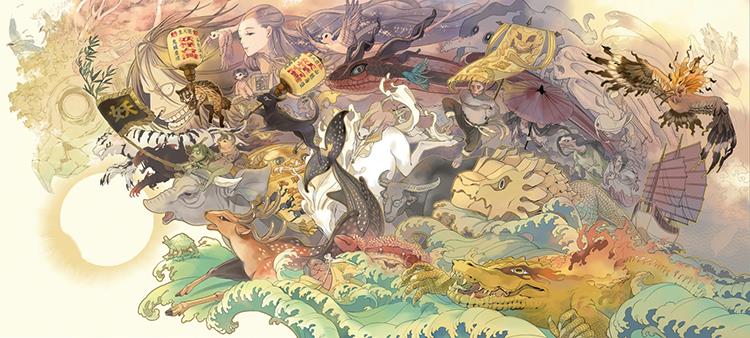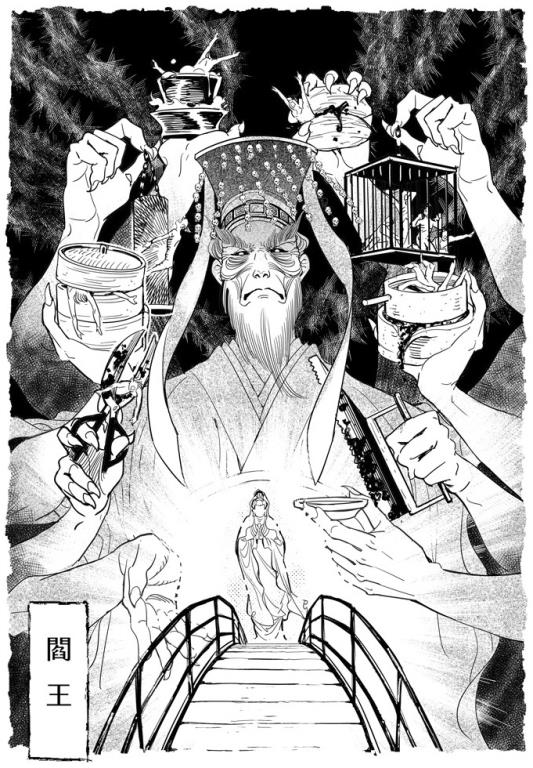Taiwan's Enchanting Demon and Monster Stories
◎English translation: Hou Ya-ting
◎Photos by Lin Che-li
◎Illustration by Jhang Ji-ya
◎Illustration courtesy of Linking Publishing
Taiwan's diverse and rich folklore features a great many stories about deities and ghosts, but local demons and monsters lurk in obscurity. Fortunately, some enthusiasts of Taiwan's demon and monster tales have compiled local stories, enabling people to scrutinize how these ghouls and evil creatures are embedded in vernacular culture. One notable enthusiast is Mr. He Jing-yao, who earlier this year published a compilation of demon and monster tales that spans three centuries of Taiwan's history.
Mr. He says it was his immersion in Taiwan's history which led him to stumble upon the world of local monster stories. Mr. He points out that the value of such tales lies in their links to local history. For example, Kaohsiung's distinct geographic features are behind various legends. Legend has it that Mount Banping, a mountain in Zuoying that runs northeast-southwest, was inhabited by a monster deer back in the Cing-dynasty, which ruled Taiwan between 1684 and 1895. Whenever the monster roared, its supernatural power would cause a fire.

It was widely believed the monstrous deer possessed a pair of fangs. Similar tales of monster deer exist in every region. One legend says the monster deer is in fact a mountain god. Whenever it roars, it will bring about a downpour or cause flooding within three days. Many believe the sound of such deer is like that of a crying baby. Because the mountainous parts of Greater Kaohsiung receive more rain than the lowlands, inhabitants used to attribute floods to the monster deer and its supernatural powers. The deer that dwelt on Mount Banping even evolved into a creature that could create fire. Until now, a statue of the deity guards the Mount Banping area against fire.
In Meinong District, by contrast, a supernatural deer was seen as a benevolent deity. Legend has it that an elderly monster deer was roaring all the way from the mountains to flat lands at Meinong sometime before Tomb Sweeping Festival in the second month on the lunar calendar. Local folk regarded it as a warning there would be torrential downpours. Their fears were realized within three days. Fierce rains whipped through the area and the rivers rose. Mercifully, the flood did not bring the devastation the villagers had feared. From that time on, Meinong residents passed down a tradition of worshiping rivers, Tudi Gong (the Earth Lord), and the celestial emperor Yu Huang Dadi in the second month on the lunar calendar, paying tribute to these deities and praying for a peaceful and prosperous year. As part of the event, Taiwanese drama troupes perform for the deities.
Back in the Cing-dynasty, a monster monkey was a bete noire in Kaohsiung's Fongshan District. Legend has it that the monkey harassed local women and stoked fears throughout the neighborhood. A senior official, Mr. Fang Bang-ji, was also a Taoist priest who possessed magical powers. Seeing how much trouble was caused by the monkey, Mr. Fang conducted a rite, invoking his magic in a bid to defeat the simian. During the epic battle, while Mr. Fang tried to complete the rite, continuous thunderstorms reflected the ferocity of the struggle between good and evil. Finally, a powerful bolt struck the ground, making a hole and fatally injuring the beast. The troublesome monkey was gone for good.
Interestingly, legends depict many monsters as having certain human characteristics. It is recorded that, in Dashu District's Jioucyutang in 1909, the Wu family was attacked by stones which some people believed were thrown by naughty fairies. The sight of mysterious stones hurtling toward the house frightened local residents.
 Some stories feature creatures with endearing character traits. One legend of the Hla' alua Tribe in Namasia District concerns friendly interactions between a ghost and a child. Many believed that ghosts could travel freely between the human world and the afterworld. This story is about a child left alone at home while the adults were working outside. A naughty ghost suddenly appeared out of nowhere, and the child was petrified. The youngster burst into tears. To comfort the child, the ghost then made grilled sticky-rice cake. When the adults returned home, they commented on the sticky-rice cake. The child told them about the ghost who had emerged from the ground, and grilled the cake until it was permeated with oil. Surprisingly, the ghost then disappeared, and was never seen again.
Some stories feature creatures with endearing character traits. One legend of the Hla' alua Tribe in Namasia District concerns friendly interactions between a ghost and a child. Many believed that ghosts could travel freely between the human world and the afterworld. This story is about a child left alone at home while the adults were working outside. A naughty ghost suddenly appeared out of nowhere, and the child was petrified. The youngster burst into tears. To comfort the child, the ghost then made grilled sticky-rice cake. When the adults returned home, they commented on the sticky-rice cake. The child told them about the ghost who had emerged from the ground, and grilled the cake until it was permeated with oil. Surprisingly, the ghost then disappeared, and was never seen again.
Like folk tales in other countries, Taiwan's legends often carry messages that aim to encourage people to realize the virtues of good deeds and proper behavior. Legend has it that even a water ghost usually considered to be the most malevolent of spirits-could attain the position of "Chenghuang" (a lord of the moat and walls, in other words a god overseeing a town or city) if it continually cultivated itself.
As these unique stories have evolved and circulated, the demons and monsters which exist somewhere between reality and imagination serve as a lively bridge between generations, and breathe life into local custom and traditional culture.
by 2017/10/17 第04期 KH Style